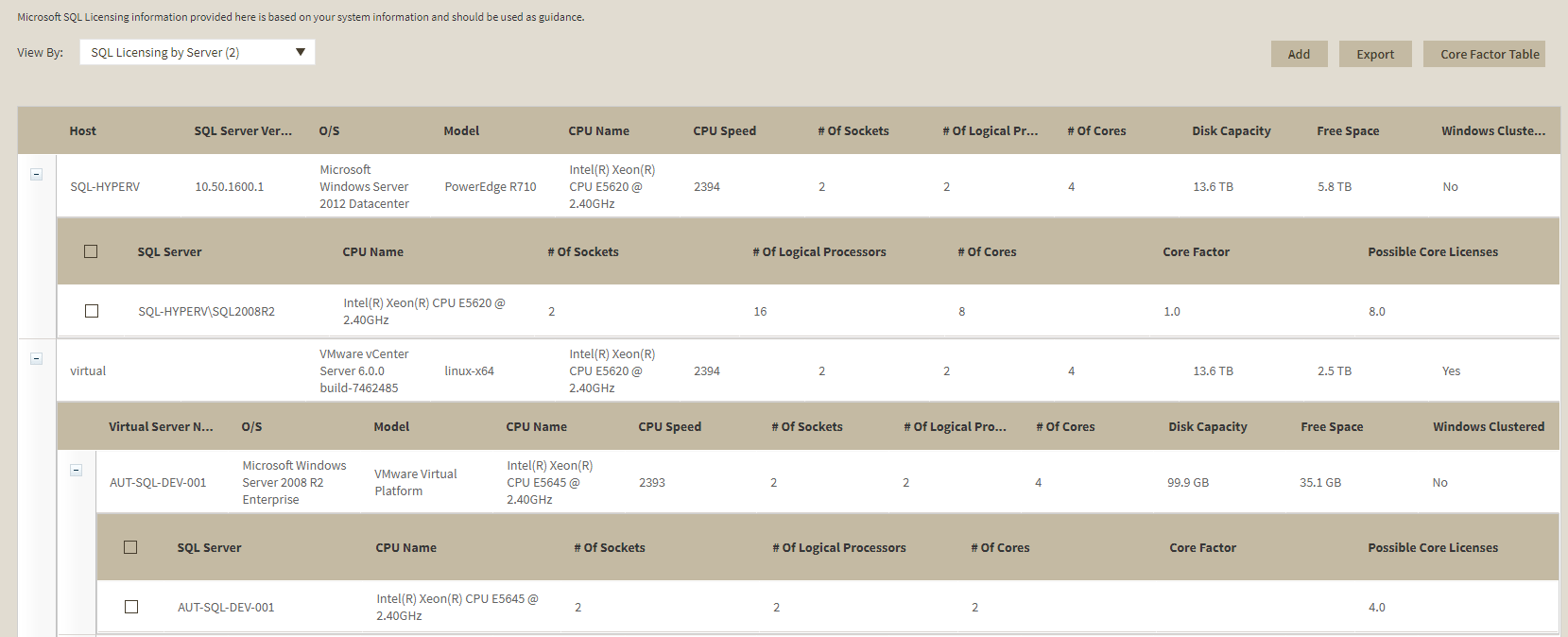Page History
| Note |
|---|
The SQL The SQL Licensing by Server view only shows the highest highest SQL Server version and edition for all the SQL instances registered and linked to the host. If a host server has additional SQL Server instances with higher version and edition that have not been registered to SQL Inventory Manager, then the higher version and edition will not be displayed on the Server/Host Server viewNo information is available for unregistered on unlinked SQL instances. |
| Info |
|---|
Microsoft SQL SERVER licensing information provided within IDERA SQL Inventory Manager is based on your system information and is only for guidance. |
...
To access this view, go to the Instances tab, and then select SQL Licensing by Server.
To find more information on how to determine Microsoft SQL Server licenses, refer to
| Newtab2 | ||||
|---|---|---|---|---|
|
...
- Add SQL Server instances. Click this option to go to the respective wizard and add new SQL Server instances.
- Export . You can choose any of the following formats: PDF, XLS, or XML for exporting the information displayed on the SQL Licensing view.
- Core Factor Table. Click this option to open the Core Factor Table for viewing SQL Server core-specific information for your instances.
...
- View details
- Edit instance properties (Owner, Location, Comments and Credentials)
- Edit Tags
- Export
Refresh data
More actions: Decommission, Remove, Add, and Core Factor Table.
- Advanced filters
Viewing instance details
You can access an instance details view by selecting the instance and clicking View Details on the action items bar or by clicking directly on the instance name. For more information about what information is available on the instance details view, refer to Viewing instance details.
...
- # of Sockets. Displays the number of cores per processor, whether physical or virtual.
- # of Cores. Displays the sum of all the cores on a system. For example, if a system includes six cores per processor and contains two processors, then the total # of cores is 12. note that the sum does not mix physical and virtual cores but displays each type as a separate line. Check the Virtual column for each row to determine if the core is virtual (displays "Yes") or physical (displays "No").
- Core Factor. Displays a numerical value that determines the number of core licenses necessary. While an administrator can change this value in the Core Factor Table, this number is provided by Microsoft based on the CPU in use.
- Possible Core Licenses. Displays the product of the total number of cores on a system multiplied by the Core Factor.
- Fully Licensed with SA. Check this box to remove the license count for the instance. You can also manage this setting in the Edit MS SQL Server License Information dialog box.
- Last Changed. Displays a timestamp of the most recent change to this record. Changed values include SQL Server major version, CPU name, number of processors, and total number of cores.
Advanced Filter
Apply advanced filters to your instances view, for more information refer to Filtering and Sorting.
Clear Filters
Clears any applied advanced filters.
Options available for multiple Instances
...
- Edit Owner
- Edit Location
- Edit Credentials
- Edit Tags
- Export
- More Actions (Decommission, Remove, Add, and Core Factor Table)
- Apply filters
For example, if you have a new DBA, you can select all instances on this tab and click Edit Owner to change all instances owner at once.
...
On the action items bar of the SQL Licensing view, you can find the Export option which allows you to choose your preferred format for exporting the information available on this view. You can export as a PDF, XLS, or XML file. The filters you choose on this view will be taken into account for your exported reports.
Filtering
...
and Sorting
SQL Inventory Manager offers different ways of sorting and filtering the listed instances/servers, for further information refer to Filtering and Sorting
On the left section of this view you can find options for filtering your instances by Tags, Owner, Location, and Version. Use these filters to quickly access specific instances that you want IDERA SQL Inventory Manager to display on this view. For example, you can choose to display the licensing information of instances that have a specific tag in your environment.
Creating a useful filter to "weed out" unnecessary information takes time but is important when managing large environments. As a result, you may want to save that filter for future use. IDERA SQL Inventory Manager now allows you to save filters for use in the Explorer and Instances views. Simply create the filter, and then click Save as Explorer favorite or click Save as Instances favorite, depending on which view you are in when creating the filter. To use that filter, click Load Explorer favorite or click Load Instances favorite.
You can enable or disable the option Apply filter as it changes depending if you want to see the changes as you apply the filter, or if you prefer to select your filters first and see the results when you finish.
| Tip | ||
|---|---|---|
| ||
| IDERA SQL Inventory Manager displays the filters you select on the top section of your managed instances view under Filtered by.You can remove filters from this section too. |
...
